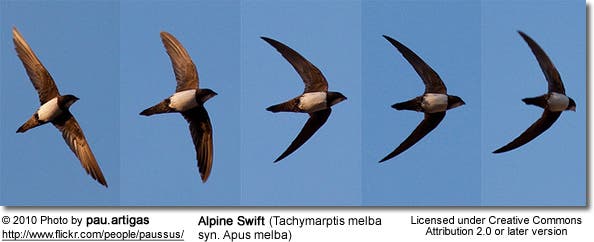All migrating animals, whether they do it by walking, swimming or flying, are nothing less than amazing. The intense energy expenditure most migrating species make to reach breeding grounds or safe, warm areas is absolutely amazing. Even after traveling thousands of miles away from home, animals like the freshwater salmon still know how to make their way back with pinpoint accuracy. The Alpine swift, a swallow-like bird species, is perhaps particularly impressive in its migrating pattern. This remarkable bird leaves its breeding grounds in Switzerland every winter to travel to the warmer shores of west Africa. The birds make this journey in six months, time in which they never stop flying! Actually, there’s very little evidence to suggesting how long they sleep.
Researchers had been suspecting that the Alpine swift was a remarkable migratory bird for some time, however, it was only after scientists at the Swiss Ornithological Institute and the Bern University of Applied Sciences in Burgdorf, Switzerland studied them very closely that the extent of their migratory capabilities surfaced.
Six birds were captured and fitted with a small device that logged acceleration and ambient light during the course of a year-long migration cycle that began and ended in Switzerland. Only three of them were eventually recaptured but this proved enough to reveal how the Alpine swift migrates.
Using data provided by the accelerometer, the researchers could accurately assess when the birds flapped their wings vigorously, when they glided or when they rested. The birds appeared to glide and flap throughout their entire migration across the Sahara Desert and their overwintering period in sub-Saharan West Africa. Apparently, the birds only rested their wings entirely during the breeding season in Switzerland.
“Their activity pattern reveals that they can stay airborne continuously throughout their nonbreeding period in Africa and must be able to recover while airborne,” the team writes in the report. “To date, such long-lasting locomotive activities had been reported only for animals living in the sea.”
Wait a minute? Where do these birds get all their energy – don’t they stop to eat or sleep? Whales and various migrating fish species also travel for months at a time without stopping. These swimming animals feed on the move on marine plankton. Similarly, the Alpine swifts feed mid-flight on an array of tiny bacteria, fungus, seeds, spores and small insects that get caught in air currents.
Observations show that the birds alternate between vigorous flapping and gliding when they rest. Still, the clear lack of significant resting periods suggests that the birds do not need as much sleep to perform their migration as previous research has suggested. It’s worth noting that while some marine migratory animals may swim just as long and continuously as the Alpine swift, the former have the advantage of exploiting buoyancy and thus conserve energy.
“We cannot rule out that the Alpine swifts may interrupt their flight for a few minutes,” the team writes. “Nevertheless, they must be able to accomplish all vital physiological functions in flight over a period of several months.”
I can barely perform them in bed. Well played, Alpine swifts.
The researchers detailed their findings in a paper published in the journal Nature Communications.



